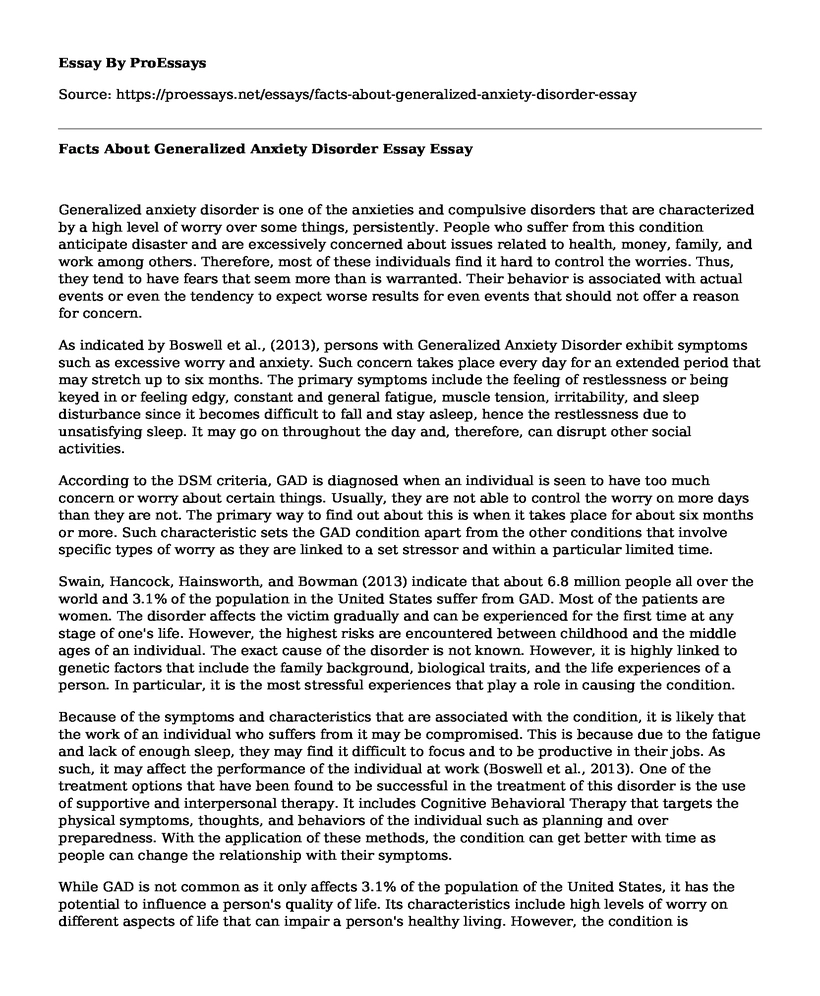Generalized anxiety disorder is one of the anxieties and compulsive disorders that are characterized by a high level of worry over some things, persistently. People who suffer from this condition anticipate disaster and are excessively concerned about issues related to health, money, family, and work among others. Therefore, most of these individuals find it hard to control the worries. Thus, they tend to have fears that seem more than is warranted. Their behavior is associated with actual events or even the tendency to expect worse results for even events that should not offer a reason for concern.
As indicated by Boswell et al., (2013), persons with Generalized Anxiety Disorder exhibit symptoms such as excessive worry and anxiety. Such concern takes place every day for an extended period that may stretch up to six months. The primary symptoms include the feeling of restlessness or being keyed in or feeling edgy, constant and general fatigue, muscle tension, irritability, and sleep disturbance since it becomes difficult to fall and stay asleep, hence the restlessness due to unsatisfying sleep. It may go on throughout the day and, therefore, can disrupt other social activities.
According to the DSM criteria, GAD is diagnosed when an individual is seen to have too much concern or worry about certain things. Usually, they are not able to control the worry on more days than they are not. The primary way to find out about this is when it takes place for about six months or more. Such characteristic sets the GAD condition apart from the other conditions that involve specific types of worry as they are linked to a set stressor and within a particular limited time.
Swain, Hancock, Hainsworth, and Bowman (2013) indicate that about 6.8 million people all over the world and 3.1% of the population in the United States suffer from GAD. Most of the patients are women. The disorder affects the victim gradually and can be experienced for the first time at any stage of one's life. However, the highest risks are encountered between childhood and the middle ages of an individual. The exact cause of the disorder is not known. However, it is highly linked to genetic factors that include the family background, biological traits, and the life experiences of a person. In particular, it is the most stressful experiences that play a role in causing the condition.
Because of the symptoms and characteristics that are associated with the condition, it is likely that the work of an individual who suffers from it may be compromised. This is because due to the fatigue and lack of enough sleep, they may find it difficult to focus and to be productive in their jobs. As such, it may affect the performance of the individual at work (Boswell et al., 2013). One of the treatment options that have been found to be successful in the treatment of this disorder is the use of supportive and interpersonal therapy. It includes Cognitive Behavioral Therapy that targets the physical symptoms, thoughts, and behaviors of the individual such as planning and over preparedness. With the application of these methods, the condition can get better with time as people can change the relationship with their symptoms.
While GAD is not common as it only affects 3.1% of the population of the United States, it has the potential to influence a person's quality of life. Its characteristics include high levels of worry on different aspects of life that can impair a person's healthy living. However, the condition is manageable through cognitive behavioral therapy as well as supportive and interpersonal therapy.
References
Boswell, J. F., ThompsonHollands, J., Farchione, T. J., & Barlow, D. H. (2013). Intolerance of uncertainty: A common factor in the treatment of emotional disorders. Journal of Clinical Psychology, 69(6), 630-645.
Swain, J., Hancock, K., Hainsworth, C., & Bowman, J. (2013). Acceptance and commitment therapy in the treatment of anxiety: a systematic review. Clinical Psychology Review, 33(8), 965-978.
Cite this page
Facts About Generalized Anxiety Disorder Essay. (2022, May 15). Retrieved from https://proessays.net/essays/facts-about-generalized-anxiety-disorder-essay
If you are the original author of this essay and no longer wish to have it published on the ProEssays website, please click below to request its removal:
- Essay on Understanding Mental Health
- How Aging, Ethnicity, Life Circumstances and Disease Have Affected an Aging Adult? - Essay Sample
- Borderline Disorder Treatment Essay Example
- Essay Sample on Homelessness and Stress
- Essay on Trauma Screening & Assessment: Universal Behaviors & Prediction Topics
- Rise in Post-Traumatic Stress Disorder in Children & Adolescents - Essay Sample
- Essay Example on Second Language Learning: Cognitive & Affective Factors







